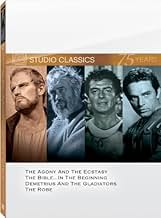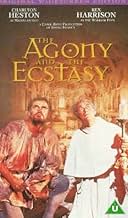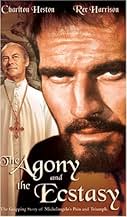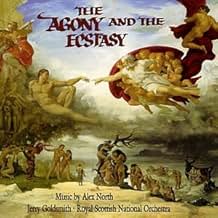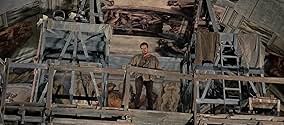IMDb RATING
7.2/10
8.5K
YOUR RATING
The biographical story of Michelangelo's troubles while painting the Sistine Chapel at the urging of Pope Julius II.The biographical story of Michelangelo's troubles while painting the Sistine Chapel at the urging of Pope Julius II.The biographical story of Michelangelo's troubles while painting the Sistine Chapel at the urging of Pope Julius II.
- Nominated for 5 Oscars
- 3 wins & 9 nominations total
Fortunato Arena
- Pope's Bodyguard
- (uncredited)
Lars Bloch
- Baron Von Silenen
- (uncredited)
Angelo Boscariol
- Papal Guard
- (uncredited)
Calisto Calisti
- Physician
- (uncredited)
Amerigo Castrighella
- Quarry cart assistant
- (uncredited)
Anita Ceccotti
- Woman Under the Chapel
- (uncredited)
Enrico Chiappafreddo
- Tavern Customer
- (uncredited)
- Director
- Writers
- All cast & crew
- Production, box office & more at IMDbPro
Featured reviews
The film is an epic grandeur feature of a interpersonal tug-of-war between the maestro Michelangelo and Pope Julius II.
I cannot help being shell-shocked to see the reconstruction of the magnificent ceiling though recognizably most of which is the trickery of montage (not in the real the Sistine Chapel, the location was inside Cinecitta Italy instead), but bathing under the glamour and solemnness of the visual wonders, I am stunned to exude my admiration and awe!
The two leads conspicuously stimulate a Moses versus Caesar confrontation, Charlton Heston seems to be more boorish than artistic to manifest a struggled Michelangelo, may God doesn't distinguish his people by their looks. The "agony and ecstasy" is watered down to an underwhelming stalemate thanks to Charlton's outlandish incarnation as the most eminent artist of that time. Rex Harrison, is by far and large worthy another Oscar nomination for his arresting devotedness, which is apt to impress the audience with a mind-blowing bi-polar characterization while good and evil coexist at the same time.
The film was a grave box office fiasco when it came out in 1965, however, judging by my appraisement, its merits still can be appreciated by our generation (a well-balanced script, the haunting original score and all the props and settings). However, the film entirely skipped Michelangelo's sexual orientation and awkwardly ploys a portentous conversation between Michelangelo and his admirer Contessina de'Medici (a over-wise Diane Cilento), which unveiled its cowardliness and helplessness.
My final remark is that as time goes by ruthlessly, art stands still and never fades away, so lucky enough cinema is yet a part of it.
I cannot help being shell-shocked to see the reconstruction of the magnificent ceiling though recognizably most of which is the trickery of montage (not in the real the Sistine Chapel, the location was inside Cinecitta Italy instead), but bathing under the glamour and solemnness of the visual wonders, I am stunned to exude my admiration and awe!
The two leads conspicuously stimulate a Moses versus Caesar confrontation, Charlton Heston seems to be more boorish than artistic to manifest a struggled Michelangelo, may God doesn't distinguish his people by their looks. The "agony and ecstasy" is watered down to an underwhelming stalemate thanks to Charlton's outlandish incarnation as the most eminent artist of that time. Rex Harrison, is by far and large worthy another Oscar nomination for his arresting devotedness, which is apt to impress the audience with a mind-blowing bi-polar characterization while good and evil coexist at the same time.
The film was a grave box office fiasco when it came out in 1965, however, judging by my appraisement, its merits still can be appreciated by our generation (a well-balanced script, the haunting original score and all the props and settings). However, the film entirely skipped Michelangelo's sexual orientation and awkwardly ploys a portentous conversation between Michelangelo and his admirer Contessina de'Medici (a over-wise Diane Cilento), which unveiled its cowardliness and helplessness.
My final remark is that as time goes by ruthlessly, art stands still and never fades away, so lucky enough cinema is yet a part of it.
"The Agony and the Ecstasy" is the story of Michaelangelo and his painting of the Sistine Chapel at the behest of Pope Julius II, a warrior and Patron of the Arts.
But it's really about so much more - the connection between art and the artist, faith, will, and the quest for perfection. Most of all, it's about the complicated relationship of two determined men, Michaelangelo and Pope Julius, which is adversarial and even violent.
The color and scenery in this film are truly beautiful, but I'd love to see a restored print, as I imagine the colors would even be richer.
Charlton Heston is a convincing and strong Michelangelo in what may be his best performance. It's buoyed by the magnificent work of Rex Harrison as Julius II. The two spark one another, and the result is an exciting screen teaming. There is hatred, resentment, a battle of wills, love and admiration between them, the agony and ecstasy of connecting with another, as Diane Cilento says in the film. She plays a woman in love with Michaelangelo. He explains that he cannot love her because of the commitment he has made to his true love, his art. The book hints at Michaelangelo's homosexuality, and it's covered with one line. After Michaelangelo says that he cannot match her feelings, he looks at a sketch of a nude man. "And it's not that either," he says.
Many scenes stick out. The somewhat hokey one in the mountains, when Michaelangelo looks at the heavens and receives his inspiration is nevertheless a gorgeous scene; the incredible scene when Michaelangelo discovers the Pope alone at night with a candle studying the ceiling is perhaps the best, as Michaelangelo explains his concept of God and faith. And the last scene between the two men is unforgettable.
There is a documentary about Michaelangelo and his work before the movie begins. A magnificent film. Don't miss it.
But it's really about so much more - the connection between art and the artist, faith, will, and the quest for perfection. Most of all, it's about the complicated relationship of two determined men, Michaelangelo and Pope Julius, which is adversarial and even violent.
The color and scenery in this film are truly beautiful, but I'd love to see a restored print, as I imagine the colors would even be richer.
Charlton Heston is a convincing and strong Michelangelo in what may be his best performance. It's buoyed by the magnificent work of Rex Harrison as Julius II. The two spark one another, and the result is an exciting screen teaming. There is hatred, resentment, a battle of wills, love and admiration between them, the agony and ecstasy of connecting with another, as Diane Cilento says in the film. She plays a woman in love with Michaelangelo. He explains that he cannot love her because of the commitment he has made to his true love, his art. The book hints at Michaelangelo's homosexuality, and it's covered with one line. After Michaelangelo says that he cannot match her feelings, he looks at a sketch of a nude man. "And it's not that either," he says.
Many scenes stick out. The somewhat hokey one in the mountains, when Michaelangelo looks at the heavens and receives his inspiration is nevertheless a gorgeous scene; the incredible scene when Michaelangelo discovers the Pope alone at night with a candle studying the ceiling is perhaps the best, as Michaelangelo explains his concept of God and faith. And the last scene between the two men is unforgettable.
There is a documentary about Michaelangelo and his work before the movie begins. A magnificent film. Don't miss it.
I like historical films. Recently I watched three historical films all made in the early 1960s. These are 'El Cid', 'The Spartacus' and 'The Agony and The Ecstasy'. Of the three, I rate The Agony and the Ecstasy as the best. This film is based on the eponymous novel written by Irving Stone. I had read the book nearly a decade back and it was nice to see the film finally. The film is about the circumstances under which Michelangelo came to compose his famous frescoes in the Sistine Chapel of Rome in the 16th century. The Sistine fresco, the 'creation of man' has become almost an emblem for the artist. But not many know that Michelangelo painted the Sistine frescoes reluctantly, only because he was forced to do so by his patron, Pope Julius II. The film is about the war of wits between these two great men Pope Julius II is a warrior pope, a worldly Pope. His concern is to protect the papal states from being over run by warring European powers. For this he is willing to take up arms. The pope knows that the posterity wont remember him for his spiritual prowess or leadership. Therefore he want to leave great works of art as his legacy. He therefore hires Michelangelo to paint the ceiling of the Sistine Chapel. The artist is not very keen on painting and considers sculpture to be his true calling. He is also not willing to conform to the prevailing canons of artistic excellence. He feels constrained by the limits of time and money that is set. All the great moments of the film occur when the Pope and the Artist clash. It is a clash of ideas and world views: (1) Whether sculpture is a superior form of art as compared to painting; (2) Whether it is appropriate depict biblical figures in their raw humanity; (3) Whether it is moral for a man of god to take arms for his principles and so on. For me the finest scene in the film is where the Pope and the Cardinals come to see the frescoes and judge it as lacking in good taste. The Artist is forced to give a strong rebuttal and in the process he expounds the humanist philosophy of art. Shot in beautiful Technicolor, the film still looks spectacular. It is a visual and intellectual treat.
The picture deals with Michelangelo or Michael Angel (Charlton Heston) who is working on the Carrara's marble creating sculptures and he is then ordered by Pope Julius II (Rex Harrison) the painting of as called Sistine chapel (that's why it was built by Pope Sisto) . Meanwhile , they'll develop various relationships with other Renaissance's important people . The film is correctly based on historical deeds and appearing famous roles , such as : Raphael (Tomas Milian) who shows up painting the ¨Athenas' school¨, Bramante (Harry Andrews) builder of the Vatican dome that hold his name , Girlandaio , Florence Medicis' descendants (Diane Cilento and Adolfo Celi) and duke of Urbin (Alberto Lupo). Besides , the film paces itself the confrontation between Julius II troops and the French/German army for the possession of the Pope's states . There are epic and impressive battles where the Pope himself fights enemies . The motion picture describes specially the creation of the enormous paintings on the ceiling and the difficulties that Michael Angel is suffering to achieve the immortal legacy . The Pope Julio II will also assign him the realization of his tomb .
The feature movie obtained a limited success and had a moderated box-office ; however , being nowadays better valued than the past . First-range acting by the two main actors : Charlton Heston and Rex Harrison , both of whom are magnificent . However , Rex Harrison did not get along with Charlton Heston at all during shooting ; in fact , twelve years later, while filming as secondary actors ¨Crossed swords¨ (1977) directed by Richard Fleischer , Rex avoided him utterly . Leon Shamroy's cinematography is rousing , the colorful paintings are glowing and brilliant ; spectacularly showing Bible's scenes at the Sistine Chapel . Alex North musical score is riveting (like ¨Spartacus¨ who he equally composed) . The sets are overwhelming and breathtaking , they were stunningly designed by production designer John De Cuir . In addition , evocative as well as adequate costumes by Oscarized Vittorio Nino Novarese . Carol Reed production and direction were excellent , he'd got much experience through a long career and had directed other classic movies (The third man) . Rating: Very good , above average and well worth seeing.
The feature movie obtained a limited success and had a moderated box-office ; however , being nowadays better valued than the past . First-range acting by the two main actors : Charlton Heston and Rex Harrison , both of whom are magnificent . However , Rex Harrison did not get along with Charlton Heston at all during shooting ; in fact , twelve years later, while filming as secondary actors ¨Crossed swords¨ (1977) directed by Richard Fleischer , Rex avoided him utterly . Leon Shamroy's cinematography is rousing , the colorful paintings are glowing and brilliant ; spectacularly showing Bible's scenes at the Sistine Chapel . Alex North musical score is riveting (like ¨Spartacus¨ who he equally composed) . The sets are overwhelming and breathtaking , they were stunningly designed by production designer John De Cuir . In addition , evocative as well as adequate costumes by Oscarized Vittorio Nino Novarese . Carol Reed production and direction were excellent , he'd got much experience through a long career and had directed other classic movies (The third man) . Rating: Very good , above average and well worth seeing.
The Agony and the Ecstasy is the story of the creation of the Sistine Chapel Roof painting, the time and money it took while Pope Julius II was busy establishing his Papacy as a political force.
Back in those days the Pope was far more than the head of the Roman Catholic Church. He ruled a considerable piece of real estate in the center of the Italian peninsula that were called the Papal States. They varied in geographic size depending on how relatively strong the Pope or his enemies were at a given time. The Papal States were the last independent entity to join a united Italy in 1870.
The Borgias had been nibbling away at the Papal States for years and their triumph became complete when one of their's became Pope Alexander VI in 1491. When Giuliano Della Rovere became Julius II in 1503 succeeding Alexander VI he had it in mind to reclaim the states from the Borgias and their backer the French monarchy. Those are the folks you see Rex Harrison fighting at the beginning of the film.
In fact Harrison's identity as the warrior Pope is made clear right at the beginning of the film when after we see this figure on a white horse killing some foes in battle, he takes off his helmet and some attendees put his papal vestments right over his armor.
But Julius II wanted to be known as a patron of the arts as well as the warrior Pope. His uncle Pope Sixtus VI had built the Sistine Chapel which is today the personal chapel of the papal residence. According to Wikipedia its dimensions are exactly what the Bible lays down as the dimensions King Solomon built his temple. But who knows what Solomon had decorating his roof.
It's a big bare spot and who to fill it with something good. Julius II decided on Michelangelo Buonarrati who's got quite a resume of creativity to recommend him even though it's mostly sculpture.
The film is the story of the creative differences between Michelangelo and Julius. Michelangelo is knowing he's created something for the ages, but he won't see the big picture of the here and now of Renaissance European politics which Julius II has to deal with.
Sir Carol Reed directed The Agony and the Ecstasy and does a marvelous job of creating the look and atmosphere of the Renaissance in Italy. Charlton Heston and Rex Harrison playing Michelangelo and the Pope give outstanding performances.
If the film has a weakness is that it really is a two man show with no other characters developed in any way. The rest of the mostly Italian cast just serve as a crowd.
If you're either a patron of the arts or a Catholic who would like to know how the Sistine Chapel acquired its legendary roof than by all means see The Agony and the Ecstasy.
Back in those days the Pope was far more than the head of the Roman Catholic Church. He ruled a considerable piece of real estate in the center of the Italian peninsula that were called the Papal States. They varied in geographic size depending on how relatively strong the Pope or his enemies were at a given time. The Papal States were the last independent entity to join a united Italy in 1870.
The Borgias had been nibbling away at the Papal States for years and their triumph became complete when one of their's became Pope Alexander VI in 1491. When Giuliano Della Rovere became Julius II in 1503 succeeding Alexander VI he had it in mind to reclaim the states from the Borgias and their backer the French monarchy. Those are the folks you see Rex Harrison fighting at the beginning of the film.
In fact Harrison's identity as the warrior Pope is made clear right at the beginning of the film when after we see this figure on a white horse killing some foes in battle, he takes off his helmet and some attendees put his papal vestments right over his armor.
But Julius II wanted to be known as a patron of the arts as well as the warrior Pope. His uncle Pope Sixtus VI had built the Sistine Chapel which is today the personal chapel of the papal residence. According to Wikipedia its dimensions are exactly what the Bible lays down as the dimensions King Solomon built his temple. But who knows what Solomon had decorating his roof.
It's a big bare spot and who to fill it with something good. Julius II decided on Michelangelo Buonarrati who's got quite a resume of creativity to recommend him even though it's mostly sculpture.
The film is the story of the creative differences between Michelangelo and Julius. Michelangelo is knowing he's created something for the ages, but he won't see the big picture of the here and now of Renaissance European politics which Julius II has to deal with.
Sir Carol Reed directed The Agony and the Ecstasy and does a marvelous job of creating the look and atmosphere of the Renaissance in Italy. Charlton Heston and Rex Harrison playing Michelangelo and the Pope give outstanding performances.
If the film has a weakness is that it really is a two man show with no other characters developed in any way. The rest of the mostly Italian cast just serve as a crowd.
If you're either a patron of the arts or a Catholic who would like to know how the Sistine Chapel acquired its legendary roof than by all means see The Agony and the Ecstasy.
Portrayals of the Pope On Screen
Portrayals of the Pope On Screen
Take a look at actors who have portrayed the Pope in movies and on television. And no, we're not going to spoil Conclave if you haven't watched it yet.
Did you know
- TriviaThe book on which this movie is based covers the entire life of Michelangelo Buonarroti. This movie based on a single chapter. One of the shortest, if not the shortest, in the entire book.
- GoofsAs shown in the movie, Michelangelo created a flat wooden platform on brackets built out from holes in the wall, high up near the top of the windows. But contrary to what is depicted in the film, he did not lie on this scaffolding while he painted, but painted from a standing position.
- ConnectionsEdited from Prologue: The Artist Who Did Not Want to Paint (1965)
- How long is The Agony and the Ecstasy?Powered by Alexa
Details
- Release date
- Country of origin
- Languages
- Also known as
- La agonía y el éxtasis
- Filming locations
- Piazza del Popolo, Todi, Perugia, Umbria, Italy(St. Peter's Square scene)
- Production company
- See more company credits at IMDbPro
Box office
- Budget
- $10,000,000 (estimated)
- Runtime2 hours 18 minutes
- Color
- Aspect ratio
- 2.20 : 1
Contribute to this page
Suggest an edit or add missing content





